It was the summer of 2009 when I first encountered the work of the actress Merle Oberon (1911–79). I was on the cusp of my senior year of high school, and my lifelong devotion to the Oscars—an event I followed with the avidity of a sports enthusiast—led me to idle those months away researching the history of the awards. Oberon, I learned, had been the first performer of color to receive a nomination of any kind when she was recognized in the best-actress category for her role in the drama The Dark Angel (1935). But it was the wrinkle in her story that resonated.
At the command of her publicists, Oberon insisted she was the progeny of white gentry born in Australia. She concealed from the public that, in actuality, she had been born into poverty in India, the illegitimate daughter of a South Asian mother and a white father. By agreeing to this contract, Oberon was able to take on such leading roles as Cathy in Wuthering Heights (1939), a part that secured her screen immortality.
My enchantment with Oberon, who lived in a time when few South Asian faces like my own populated Hollywood’s screens, would eventually lead me to write Love, Queenie: Merle Oberon, Hollywood’s First South Asian Star. Received wisdom about Oberon’s career suggests that it was purely the racist prescriptions of the Production Code (or Hays Code, named after William H. Hays, the president of the Motion Picture Producers and Distributors of America at the time) that pushed the actress to “pass” as white. But my research revealed a more complex web of discrimination that made the denial of her heritage crucial for her to build a life in the United States.
After earning her stripes in British cinema during the early 1930s with films such as The Private Life of Henry VIII (1933) and The Scarlet Pimpernel (1934), Oberon came to Hollywood in 1934. That very year saw American studio filmmaking adopt the Hays Code, which forbade any depiction of miscegenation between Black and white races. This stipulation, however, was often interpreted broadly enough to kneecap leading opportunities for all performers of color, Black or otherwise.
But another agitating factor—one that was not immediately apparent to me until I spent time with Oberon’s immigration and travel records—made passing obligatory for her. The Immigration Act of 1917 imposed a wholesale ban on immigration from India. Indian immigrants like Oberon who already resided in the United States were, too, ineligible for American citizenship, per a 1923 Supreme Court ruling. These laws resulted from long-percolating animus toward the “Hindu,” as Indian immigrants were often called. (Whether the targets of such enmity were Sikh, Muslim, or Jain did not matter.) Indeed, as I trawled through archival materials, offhand newspaper rumors about Oberon’s “Hindu” heritage no longer seemed like harmless pabulum peddled by columnists. Rather, those mentions were fraught with danger.
I sought to map Oberon’s life against these tectonic shifts in American attitudes toward India. By 1946, a quota of Indian immigrants was permitted to enter the country legally, and they were also now eligible for naturalized citizenship. “I have come to the happy conclusion that I want something more than just an American film career,” Oberon would tell the press in 1953 of her ambitions to gain American citizenship. “I want to belong to this country.”
But she did not follow through on the plan, her immigration records showed, fearful of any publicity the pursuit would generate. Aspects of her birth country’s culture—its music, fashion, food—would permeate the Zeitgeist as the counterculture held sway throughout the 1960s: see, for example, the popularity of the musician Ravi Shankar through his association with the Beatles. But late in life, Oberon was “trapped,” her best friend, Luis Estévez, would say in a television interview, “in a lie she did not create.”
Though Oberon’s origins became widely known in the years after her death, she now occupies a diminished position in cultural memory. Today, she is neither an icon of progressive racial representation in the vein of her contemporaries, such as Anna May Wong or Sessue Hayakawa, nor regarded as an actress of superlative thespian ability like Bette Davis or Katharine Hepburn.
My aim with this book was not only to reposition Oberon as one of the golden age’s major talents but to put her life and work in concert. One appreciates her art more when the journey she took is better understood. Her story is a tragedy, yes, of the way discrimination in its many forms can limit one’s opportunities for ascendance—but it is also a narrative of triumph.
While writing, I found myself returning to an observation from Michael Korda—Oberon’s former nephew by marriage to the film mogul Alexander Korda—in his 1999 book, Another Life: Oberon was “a survivor, a strong, passionate young woman determined to make it in the great world with the weapons that were available to her.” She was, to borrow Korda’s turn of phrase, every bit the survivor—one whose work demanded never to be forgotten, even if this came at a cost.
Mayukh Sen is a 2025 Fellow at New America, and he teaches journalism at New York University


